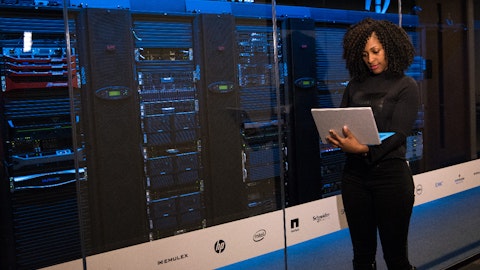These were not customers of Azure at all.Second, even Azure OpenAI API customers are all new, and the workload conversations, whether it’s B2C conversations in financial services or drug discovery on another side, these are all new workloads that we really were not in the game in the past, whereas we now are. So those are the three comments that I’d make, both in terms of absolute macro, but more importantly, I think, what is our relative market position and how it’s being changed.Amy Hood Mark, maybe the one thing I would add to those comments is, we’ve been through almost a year where that pivot that Satya talked about from we’re starting tons of new workloads, and we’ll call that the pandemic time, to this transition post, and we’re coming to really the anniversary of that starting.
And so to talk to your point, we’re continuing to set optimization. But at some point, workloads just can’t be optimized much further. And when you start to anniversary that, you do see that it gets a little bit easier in terms of the comps year-over-year. And so you even see that in a little bit of our guidance, some of that impact from a year-over-year basis.Mark Moerdler That was incredibly helpful. I really do appreciate. Thank you for the color and again, congratulations on what’s happening.Satya Nadella Thanks, Mark.Brett Iversen Joe, next question, please.Operator Our next question comes from the line of Brent Thill with Jefferies. Please proceedBrent Thill Thanks. On Copilot monetization, can you just give us a sense of how much shows up, where we’re going to see it?
And ultimately, is there a simple price lift that you think you can get through Copilot, say, 10%, 20%, 30% above where you saw the regular components of the Suite or is it too hard to factor in? Thank you.Satya Nadella I mean, overall, we do plan to monetize a separate set of meters across all of the tech stack, whether they’re consumption meters or per user subscriptions. The Copilot that’s priced and it is there is GitHub Copilot. That’s a good example of incrementally how we monetize the prices that are there out there and others are to be priced because they’re in preview mode. But you can expect us to do what we’ve done with GitHub Copilot pretty much across the board.Amy Hood Yeah, Brent. The best way of thinking about this is when we believe we’re adding a lot of value.
And frankly, that’s what the Copilots are doing and some productivity improvement, you can expect that we will have this price for those and you’ll be able to look at that as we get to release, and to Satya’s point, GitHub Copilot is a great example.Brent Thill Thanks.Brett Iversen Joe, next question, please.Operator Our next question comes from the line of Raimo Lenschow with Barclays. Please proceedRaimo Lenschow Thank you. Congrats from me as well. Just staying on the AI theme and more thinking about the gross margin impact on Azure. Can you just, Satya, can you maybe a little – talk a little bit about like how you see the cost of compute for AI workloads versus kind of the classic workloads and how do you think that will evolve over time?
Thank you.Satya Nadella Yes, a couple of them. One is clearly the accelerated compute is what gets used to drive AI. And the thing that we are very, very focused on is to make sure that we get it very efficient in the usage of those resources. If you think about sort of what the hyperscaler does, it’s not just rack and stack sort of hardware. They use software to optimize the performance of a given workload and, in fact, heterogeneous workloads on a given set of hardware.And so we have many knobs that we’ll continuously continue to drive optimization across it. And you see it even in the — even for a given generation of a large model, where we started them to the cost footprint to where we end in the cost footprint even in a period of a quarter changes.
So you can expect us to do what we have done over the decade plus with the public cloud to bring the benefits of, I would say, continuous optimization of our COGS to a diverse set of workloads.The other thing I’d mention is that there are a lot of workloads now. Like one of the reasons why we got together with OpenAI primarily was we came out and said, this type of workload, whether it’s a training or an inference workload is going to be much more generally relevant for us, not just in the context of AI. And so you can see us apply it in other context as well.Amy Hood And Raimo, we talked a bit about this when we talked about the new Edge and the new Bing with analysts. And I think one of the important things to keep in mind, which Satya is pointing to is that it’s not really just the cost of Azure and the ability to optimize across the Azure workloads.
It’s that really even our first-party workloads and apps that are built, right, are built on the same platform, and we’re able because we are a hyperscaler and because we have a large commercial cloud first-party as well as consumer apps like Bing that are first party, we’re able to take advantage of that and GPU utilization, AI services utilization across the stack. And so it’s not just sort of where Satya wanted to see even a broader benefit of being a hyperscaler.Raimo Lenschow Thank you.Brett Iversen Thanks, Raimo. Joe, next question please.Operator Our next question comes from the line of Keith Bachman with BMO. Please proceedKeith Bachman Good afternoon. Good evening. Thank you for taking the question. I want to address this up to you, if I could.
On your prepared remarks, you commented that you thought that operating expense growth would be lower. I was hoping to just maybe flesh that out with some broader comments. Could you talk about how you see any kind of directional color on how you see gross margins evolving, given mix and particularly supporting generative AI and/or any other comments that might help shape our thinking as we begin to look at the operating margin for the next fiscal year? Thank you.Amy Hood Thanks, Keith. It’s probably a good opportunity to explain a bit about how I think about where we are, which is — if you look at all of the businesses we’re in and we look about our competitiveness in those businesses. And this is before Satya started to comment a bit about our relative performance versus absolute.
And I’ll tell you that the energy and focus we put right now is on relative performance and share gains.Right now, we have the largest commercial cloud with increasing commitments by customers, with new workloads, new TAM opportunities that something you’re talking about with customers. And our focus is going to be and will be on continuing to take a growing share of that while we continue to focus on our customers’ success in getting a ton of value out of what we are selling, whether that’s the E5 product, the Microsoft 365, whether that’s Windows 365 to help, maybe it’s on compute costs and PC cost, whether it’s working across the Azure stack.And so with that opportunity plus in our consumer business, the largest number of active devices we’ve had in Windows, are still being used more being able to focus on edge share and being share and gaming — bringing it to the PC as well across to mobile, these are the opportunities that we focus on as we think about next year.And so if we feel like and I do, that we are well positioned to continue to take share in so many key places, then I say, great, and we want to be able to focus on investing in AI, which I talked about, will increase COGS growth, but we’re committed to making sure we have healthy profitability by keeping operating expenses low.
And so what really this past year has been about, but really what Q3 starts to show is our willingness to pivot to the future to make sure we can keep all those commitments that Satya listed.So while I know that’s not giving specificity, it is, in fact, how we think about long-term success, in being well positioned in big markets, taking share in those markets, committing to make sure we’re going to lead this wave, staying focused on gross margin improvements where we can. Some of them will come in AI over time, given our commitment to the build-out. We will charge for those AI capabilities and then ultimately will deliver operating profit.Satya Nadella Yeah. I mean, just to add to it, during these periods of transition, the way I think as shareholders, you may want to look at is what’s the opportunity set ahead.
We have a differentiated play to go after that opportunity set, which we believe we have. Both the opportunity set in terms of TAM is bigger, and our differentiation at the very start of a cycle, we feel we have a good lead and we have differentiated offerings up and down the stack.And so therefore, that’s the sort of approach we’re going to take, which is how do we maximize the return of that starting position for you all as shareholders long term. That’s sort of where we look at it. And we’ll manage the P&L carefully driving operating leverage in a disciplined way but not being shy of investing where we need to invest in order to grab the long-term opportunity. And so obviously, we will see share gains first, usage first, then GM, then OPInc, right, like a classic P&L flow.
But we feel good about our position.Keith Bachman All right. Many thanks for the answer.Brett Iversen Thanks, Keith. Joe, next question, please.Operator Our next question comes from the line of Karl Keirstead with UBS. Please proceedKarl Keirstead Thanks. We’ve had a lot of questions on AI and Azure, so maybe just to round it out. Just on the Office 365 business, Amy. 16% constant currency guide for June, not really seeing much seat degradation despite obviously a tight labor market, so it’s proven to be very resilient. Could you just unpack the sensitivity to that headcount reduction, given that across your customer base, at least slower rate of hiring, just given that this is an enormous seat-based business? It doesn’t seem to be showing up.
Maybe you could just help us understand what’s driving that continued seat growth and how durable that is?Amy Hood Thanks, Karl. I think I would step back and say we have seen, I mean, the Office 365 suite but broadly, the Microsoft 365 suite adds a ton of value for users. And so if you think about the users and on the global base, we’ve been able to add users, which you continue to see. We still have in the frontline scenario at an SMB opportunity to continue to grow. And in the enterprise, where we are a basic productivity tool, the labor market is still tight in most places, and we continue to see customers committed to the value they’re getting.And so I — this is not something that — I think our focus has really been on continuing to get healthy renewals, continue to add new products at renewal where it makes sense to save customers money and increase value.





